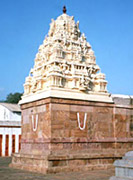 Location: Ahoblam near Kurnool
Location: Ahoblam near Kurnool
Deity: Lord Narasimha
It is a place of great antiquity. As the nine shrines are situated within a radius of five kosa or 10 miles, this Tirtham is also known as Panchakosa Tirtham.
This complex has nine temples enshrining the nine images of Narasimha. At the foothill there is the temple of Prahladavarada Narasimha. This temple lies in the center of three prakarams, and is built in the Vijayanagar style. Some distance away is the temple of Alwar Koneru, that supplies good drinking water. About a mile and a half from the temple is the Chatravata Narasimha. Thorny bushes surround the deity and the image is installed under a peepal tree.
From the foot of the hill one has to climb to reach Upper Ahobalam. The lower Ahobalam temple is built in the Vijayanagar style and on the way up you keep encountering more shrines. The uppermost temple is the Pranava Narasimha shrine. The path uphill is about six miles through virgin hills and forests. Here you will also find the Karanda Narasimha and Yogananda Narasimha temple.
After destroying Hiranyakasipu, Narasimha taught Prahlad several yoga postures and this position is called Yogananda Narasimha. At this spot the Gobhila and Bharadwaja rishis did penance to rid themselves of the sins they had committed. The temple has a magnificent mantapa and gopura. Very close to the shrine of Guha Narasimha is a huge pillar.
The upper Ahobalam is a plateau at 2,800 above sea level. The two crests of the hill are called Vedadri and Garudadri through which the sacred river Bhavanasani Tirtham flows. The Tirtham divides the two Kumadavati and Pennar rivers and then joins them. The Tirtham is said to be antarvahini - a river that flows underground for a large part of its course. On the southern slope of the hill the Lord is seen as the fierce Ugra Narasimha. According to the Puranas this is the same pillar that was kicked by Hiranyakasipu asking his son if Lord Vishnu existed in this pillar and it was from here that Ugra Narasimha emerged to kill him. Close to this shrine is the shrine of Kroda Narasimha, where he is worshipped as a boar.
It is stated that if narayana satakshari japa and parayana of Varahakanda (prayers) are recited here for three days, it bestows immense benefit to the devotee. Two miles ahead is the shrine of Malola Narasimha. The deity here is called Santaroopa and is seen with Lakshmi. The Kakatiya king Prataparudra donated the utsava vigraha made of gold to this temple. Further up is the shrine of Jwala Narasimha, where Ugrakala can be seen. This is exact spot where Narasimha is said to have torn Hiranyakasipu apart.
Close by Pavana Narasimha is worshipped as Shakta. Thus the Nava Narasimha -
1. Prahlada - Varada Narasimha or Lakshmi Narasimha
2.Chatravata Narasimha
3. Karanda Narasimha
4. Yogananda Narasimha
5. Guha Narasimha
6. Kroda Narasimha
7. Malola Narasimha
8. Jwala Narasimha
9. Pavana Narasimha is worshipped here.
The lord in upper Ahobalam is said to be Swayambu or self-manifested.
Legend: There are two legends associated with Ahobalam. The gods while witnessing the work of Ugrakala sang his praise and hence the name Ahobalam. The other version is that because of the presence of the cave Ahobila, where Garuda worshipped it came to be called Ahobila.
The Chenchu tribe are associated with Srisailam as well as Ahobalam. According to legend Lord Narayana was born as Narasimh avatar, Goddess Lakshmi was born in the Chenchu tribe, and both lived here happily. He refused to go back to Vaikuntam and this love is the theme for many Chenchu folk songs. There are other shrines here including Raktakundam. Lord Narasimha is said to have washed his hands here after killing Hiranyakashyapu and hence the water has a reddish appearance. There is a shrine of Lanja- koneru two miles to the north east en route to Bhargava.
The Ramatirtham is the sacred tank and is five miles from lower Ahobalam. The temple is very old. Vikramaditya (1076-1106 A.D.) is said to have worshipped the Moola Vigraha of this temple. Prataparudra Deva, last of the Kakatiya kings, installed the utsavavigraha of this temple. He halted at Rudravaram, 16 miles from Ahobalam and the idol was cast, and the poem Prataparudriyam was composed to commemorate it.
King Krishandevaraya visited this shrine after the conquest of Kalinga and offered a diamond necklace, wristlet, a gold plate and thousand pieces of gold to the deity.
The Upanishads state that Narasimhavatara is suited for worship for it`s anger. According to the Pancharatratstavam of Vaishnavism, the four faces of Lord Vishnu are said to be the four Vyuhas - Vasudeva, Sankarshana (Lion), Pradyumna (Boar) and Aniruddha. Thus the Narasimha type of manifestation is important vyuha of the Lord. It is stated in the Nrisimha Purvathapani Upanishad that God appeared before Brahma as Narasimha first, and gave him the mantra - Narasimha Anushtrup, with which he developed the four Vedas. In the Anushtrup, there are nine forms of Narasimhaswamy, corresponding to the Nava Narasimhas.
Those are the Ugra - angry, Veera - fighting, Mahavishnu - Lakshmi Narasimha, Jwalantha - emitting flames, Sarvathomukha - Narasimha with many faces, the Narasimha - ordinary Narasimha, the Bhishana - frightful, the Bhadra - terrible and the Mrithyormrithyu - killer/death.
Festivals: The important festival of this place is the annual Brahmotsava, that takes place on the first fortnight of Phalgun month, a fortnight after Sivaratri. They have a peculiar custom - the Padmasalis claim the divine consort was a maiden from their own class, and so claim the right to perform the Kalyanotsava of the Lord. During this festival the Lord and the Goddess are brought out to the Kalyanamantapam, and negotiations for the marriage and dowry is begun between the Padmasalis and the Lord himself. The Padmasalis form a group, and select a person to perform the marriage ceremony.











